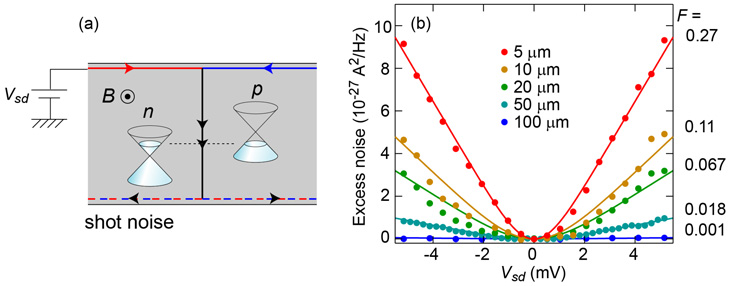Shot Noise Generated by Graphene p-n Junctions in the Quantum Hall Effect Regime
In graphene, owing to the linear and gapless band structure, a unique p-n junction, where n-type and p-type regions adjoin each other without a gap in between, is formed. In the quantum Hall effect regime under high magnetic field, counter-circulating electron and hole edge modes mix in the p-n junction [Fig. 1(a)]. In this work, we investigate the mode mixing process by shot noise measurements and suggest that the p-n junction can serve as an electronic beam splitter [1].
We used graphene grown on SiC. A p-n junction is formed by applying a gate bias to the top gate covering half of the graphene. The current injected to the p-n junction is distributed to electron and hole modes by the mode mixing and then partitioned at the exit of the p-n junction. We measured the shot noise generated by this mode mixing and the subsequent partitioning process. We demonstrate the crucial role of the p-n junction length on the mode mixing process [Fig. 1(b)]. For longer p-n junctions, the shot noise is reduced by the energy relaxation. On the other hand, for p-n junctions with the length shorter than the relaxation length (15 µm), the energy loss to the environment is negligible and the noise is consistent with a quasielastic mode mixing. This suggests that a graphene p-n junction can serve as an electronic beam splitter. Since the beam splitter is an important element of quantum optics, our results encourage using graphene for such applications.
- [1] N. Kumada, F. D. Parmentier, H. Hibino, D. C. Glattli, and P. Roulleau, Nature Commun. 6, 8068 (2015).

|
| Fig. 1. (a) Counter-circulating electron and hole edge modes in a bipolar graphene quantum Hall effect regime. (b) Shot noise as a function of the source-drain bias for the samples with different p-n junction length. |